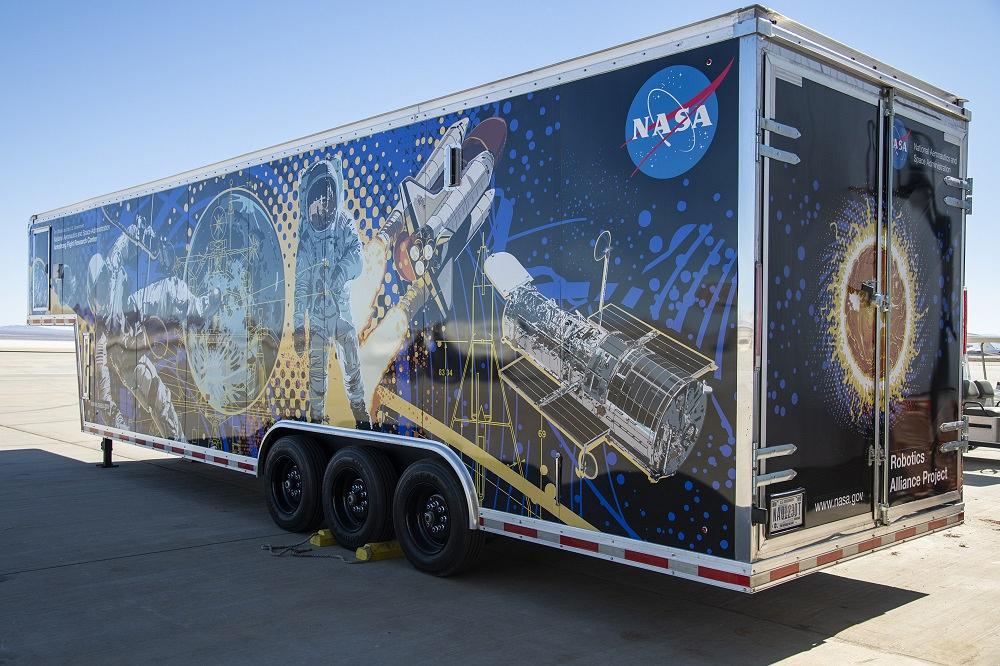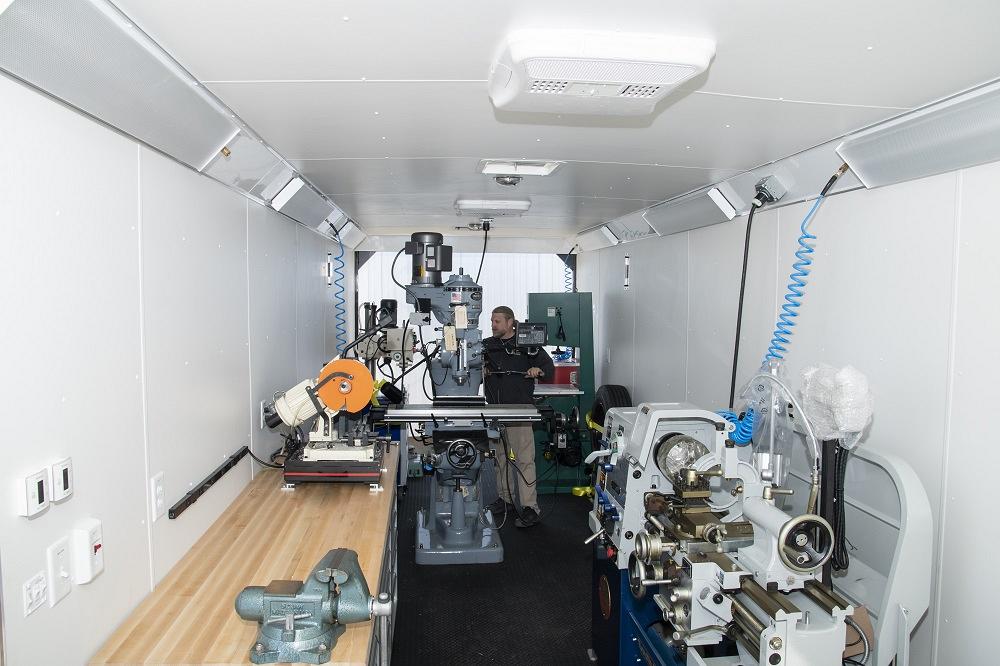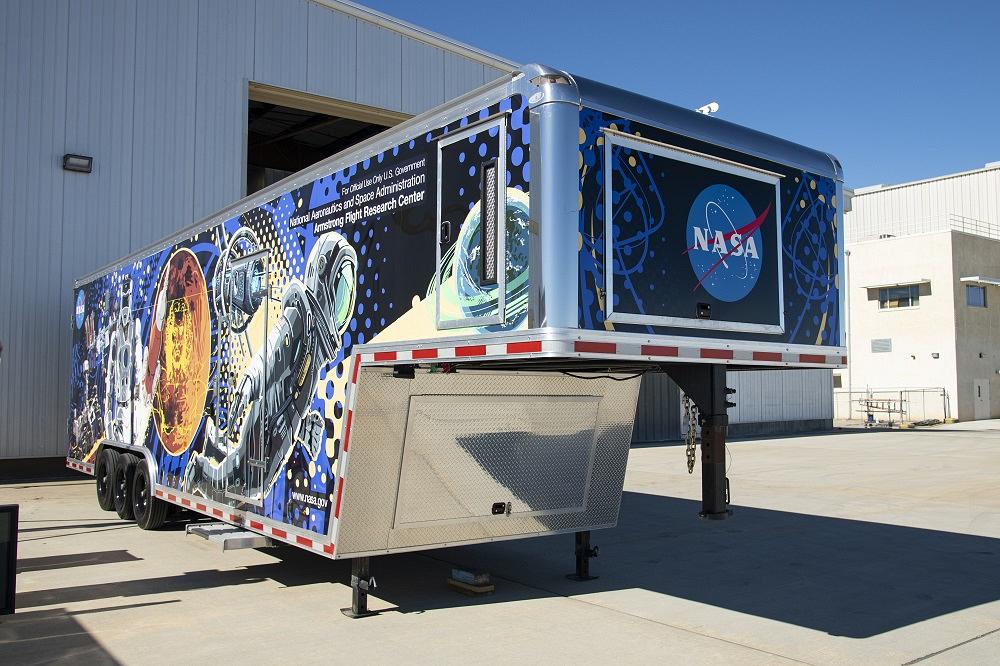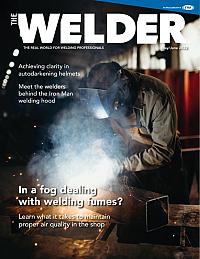Editor
- FMA
- The Fabricator
- FABTECH
- Canadian Metalworking
Categories
- Additive Manufacturing
- Aluminum Welding
- Arc Welding
- Assembly and Joining
- Automation and Robotics
- Bending and Forming
- Consumables
- Cutting and Weld Prep
- Electric Vehicles
- En Español
- Finishing
- Hydroforming
- Laser Cutting
- Laser Welding
- Machining
- Manufacturing Software
- Materials Handling
- Metals/Materials
- Oxyfuel Cutting
- Plasma Cutting
- Power Tools
- Punching and Other Holemaking
- Roll Forming
- Safety
- Sawing
- Shearing
- Shop Management
- Testing and Measuring
- Tube and Pipe Fabrication
- Tube and Pipe Production
- Waterjet Cutting
Industry Directory
Webcasts
Podcasts
FAB 40
Advertise
Subscribe
Account Login
Search
NASA uses mobile fab shop to showcase welding, fabrication to students
Armstrong Flight Research Center team repairs student robots with mobile lab
- By Rafael Guerrero
- May 20, 2022
- Article
- Arc Welding

NASA’s Armstrong Flight Research Center in California obtained a mobile fabrication shop as part of its efforts to increase youth interest in science, technology, engineering, and math (STEM). Images: NASA
NASA is much more than astronauts, pilots, and engineers.
Welders, mechanics, information technology specialists, and others keep the space agency operational—it's just that you may not hear much about them.
A new addition to NASA’s Armstrong Flight Research Center at Edwards Air Force Base in California has made some of these workers and jobs much more visible. In February the research center obtained a fabrication shop on wheels as part of its involvement in the Robotics Alliance Project (RAP), a NASA initiative aimed at increasing youth interest in science, technology, engineering, and mathematics (STEM).
The 36-ft.-long trailer includes an arsenal of onboard equipment that includes a mill, lathe, drill press, metal saw, metalworking tools, and welding equipment.
The mobile shop made its debut at three FIRST Robotics Competition events in California earlier this year. A group of Armstrong employees and one volunteer manned the shop, taking and fulfilling work-order requests submitted by students involved in the robotics competitions.
Officials said the goal is to have these mobile shops on hand at all 10 NASA centers. The shops also may be used to aid in emergency response efforts someday.
Jason Nelson, lead engineering technician, and David Voracek, chief technologist at NASA Armstrong Flight Research Center and project manager for RAP, spoke with The WELDER to discuss the mobile shop, what they assisted students with, and how they generated student interest in areas like welding.
TW: What can you tell me about the equipment inside the mobile fabrication shop?
JN: The new trailers—specifically ours—come with a 13-in. by 30-in. South Bend lathe, a Wells-Index (milling machine), refurbished full-size mill, advanced saw, a mill/drill combo, a cold-cut saw, and a 400-amp Miller welding machine with TIG and stick capabilities. We use the TIG primarily because 90% of these robots are made of aluminum.
We can do welding repairs for them on-site. The trailer also comes with its own generator if we needed to go fully mobile.

The mobile shop has onboard equipment that includes a mill, lathe, drill press, metal saw, metalworking tools, and welding equipment. Pictured is Jason Nelson, a lead engineering technician involved in the fabrication shop on wheels.
TW: What is the process for a student to have their robot repaired?
JN: Sometimes students are not aware [of the process]. They'll come out to the trailer thinking they can just run in and use some of the tooling. We can’t allow that for liability reasons.
We do have a mock paperwork order that we ask them to fill out with notes on what needs to be done. We even have a little grid on there so they can sketch out the part that they need, if they need exact dimensions made, things of that nature.
We just try to get work orders done as soon as possible for them. And that’s more so they can get used to processes once they get out of high school and into the real world. And it also helps us keep track of what we actually do.
TW: What type of work orders have you received from students?
JN: I’ve seen anything from “Hey we need to cut this shorter,” to “We need a tab,” “We broke this,” “Can you straighten this,” “Can you tap this rod for us,” “Can you weld some brackets for us,” or “Can you re-weld our robot, it cracked here.” We’ll even do some soldering.
We try to get the work orders in and out in no more than five minutes. Some of them, like welding, could take a little longer.
TW: How many orders did you receive at the Monterey, Fresno, and Lancaster, Calif.-based robotics competitions?
JN: In Monterey we processed about 60 work orders in the three days we were there. It varies from day to day. The first day—their practice day— is the heavy day and it kind of dwindles from there.
And then in Fresno I printed out 75 work orders and ran out of [the paperwork]. We did at least 80 jobs in Fresno.

NASA’s Armstrong Flight Research Center hauled the 36 ft.-long trailer to three student robotics competitions in California this spring, aiding students with repairs and maintenance work on their robots. A small group of NASA employees and volunteers took and completed work-order requests from students.
TW: Was it encouraging to witness the curiosity and interest coming from students at these competitions?
JN: To be honest, 30% of the kids are more interested in the engineering side of things. About one-third of them are more interested in the vocational side, the milling and lathing and welding aspect of it.
You do have some kids that are the manufacturers or the fabricators on their teams. Some schools are lucky enough to have shops that have a lathe or a mill or saws that they can use. But then again, it seems to be the majority of machinery in schools is very old. So, when they see ours, they get wide-eyed.
We talk to students about further education and what they’re interested in. We'll talk to vocational students about junior colleges that have the welding and machining programs. Same with the engineering students—we’ll talk to them about internships, further education, and the importance of interacting with manufacturers and fabrication shops to create the correct part they are trying to design and engineer, with the understanding that it’s a team effort amongst everyone.
Programs like this allow the kids to have that tool aspect where they can do some engineering and fabricating at the same time.
TW: A lot of people think NASA is comprised solely of engineers, astronauts, and scientists. Are there opportunities for careers at NASA in manufacturing and fabricating?
DV: I’ve been an engineer for 35 years. I’m not much of an engineer if I can’t build the things we want to make. There are so many people, like welders, that [bring life to the ideas.]
A lot of us come up with ideas, but those ideas are always improved upon when we send them to the welders and the other techs.
About the Author

Rafael Guerrero
2135 Point Blvd.
Elgin, IL 60123
(815)-227-8242
Rafael Guerrero. was named editor of The Welder in April 2022. He spent nine years as a journalist in newspapers in the Midwest and Pacific Northwest, covering topics and communities in central Illinois, Washington, and the Chicago area.
About the Publication
subscribe now

The Welder, formerly known as Practical Welding Today, is a showcase of the real people who make the products we use and work with every day. This magazine has served the welding community in North America well for more than 20 years.
start your free subscription- Stay connected from anywhere

Easily access valuable industry resources now with full access to the digital edition of The Fabricator.

Easily access valuable industry resources now with full access to the digital edition of The Welder.

Easily access valuable industry resources now with full access to the digital edition of The Tube and Pipe Journal.
- Podcasting
- Podcast:
- The Fabricator Podcast
- Published:
- 04/16/2024
- Running Time:
- 63:29
In this episode of The Fabricator Podcast, Caleb Chamberlain, co-founder and CEO of OSH Cut, discusses his company’s...
- Trending Articles
Sheffield Forgemasters makes global leap in welding technology

Welding student from Utah to represent the U.S. at WorldSkills 2024

Lincoln Electric announces executive appointments

Lincoln Electric acquires RedViking

Engine-driven welding machines include integrated air compressors

- Industry Events
16th Annual Safety Conference
- April 30 - May 1, 2024
- Elgin,
Pipe and Tube Conference
- May 21 - 22, 2024
- Omaha, NE
World-Class Roll Forming Workshop
- June 5 - 6, 2024
- Louisville, KY
Advanced Laser Application Workshop
- June 25 - 27, 2024
- Novi, MI


























